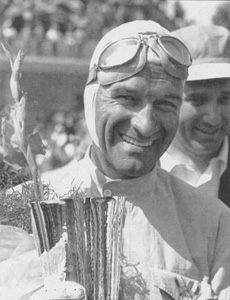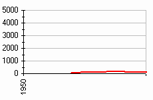Гонщики, S | |
Sommer, Raymond Курсивом отмечены гонщики, |
| Раймон СоммерSommer, Raymond |
 (c) 'Who is Who' by Steve Small, 2000 Родился: 31.08.1906 Музон, Арденны (Париж?) Умер: 10.09.1950 трасса Кадур, Тулуза Сезонов в Ф1: Лет в Ф1: 1 Гран При: Старты: 5 Победы: - подряд: Подиумы: - подряд: Поул-позиции: - подряд: Первый ряд: - подряд: Быстрые круги: - подряд: Лучший финиш: Лучший старт: 5 Дубли: Хет-трики: Лидирование старт/финиш: Большие шлемы: Круги: - лидирования: 5 Километры: - лидирования: |
Год | Команда | Шасси |
Given the format of this book, Raymond Sommer's entry is brief, and unfortunately lack of space prevents me from writing more fully about this truly exceptional individual, who surely epitomised all that is good about motor racing - courage, tenacity, enthusiasm, persistence and sportsmanship.
He first came to fame by defeating the works Alfas in his private machine at Le Mans in 1932, driving for all but three of the 24 hours. The following year he won again, this time with the legendary Nuvolari. Raymond was soon racing in Grands Prix, usually as an independent, for he could not bear the constraints teams might impose. Thus he had to make do with whatever machinery was available, and always drove it to its limits, taking great delight when he managed to beat a car from the mighty Scuderia Ferrari or Mercedes teams. In this context, his record of successes was remarkable, even if he failed to win a monoposto Grand Prix outright before the war, though he did win the French sports car GP with Wimille in 1936.
After the war, Sommer was soon back in action, and in 1946 he enjoyed his best season, which included a famous victory in the GP of St Cloud, when the works Alfa \ 158s failed. In 1947 he was out of action after inadvertently swallowing some methanol at the Pau GP, but he returned with a semi-works Ferrari the following year, winning the Reims F2 race. Equipping himself with a big Talbot Sommer was like a cat among the pigeons in 1949, hammering the car for all it was worth and frequently mixing it with the Italians, who viewed his on-the-edge, no-quarter-asked-or-given style with some concern.
He was driving as well as ever in 1950, scoring a fourth place at Monaco in his nimble Formula 2 Ferrari (with which he also took F2 wins at Roubaix, Aix-les-Bains and Bremgarten). He reverted to his Talbot for the later championship Grands Prix, where power was all, but no points were gained. It came as a huge shock when the motor racing world learned of his death while competing in a minor end-of-season 500 cc race at Cadours when, it is thought a wheel bearing seized on his Cooper.
(c) 'Who is Who' by Steve Small, 2000
| © WildSoft, 1995-2020 |


